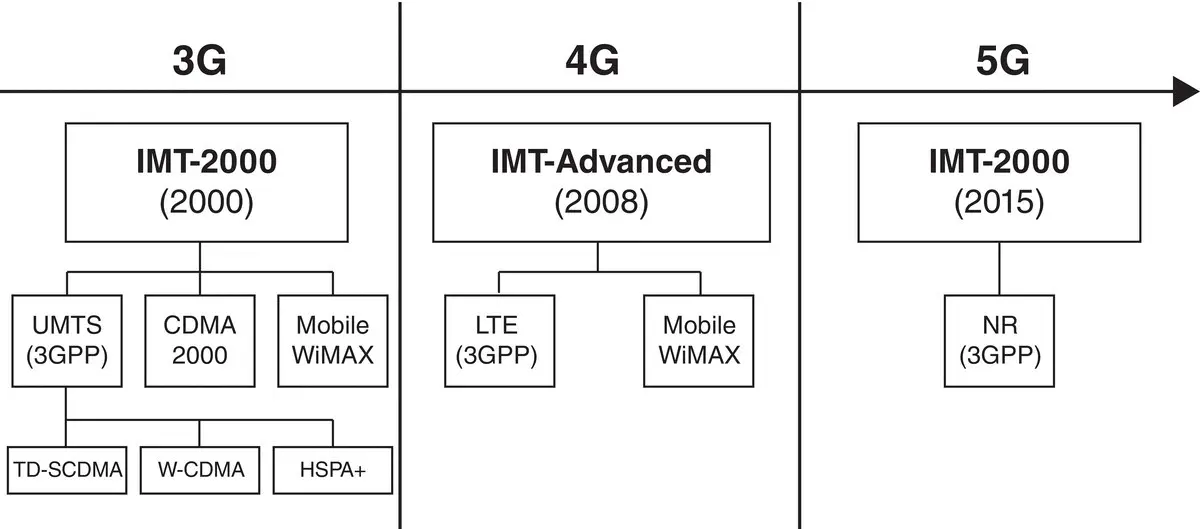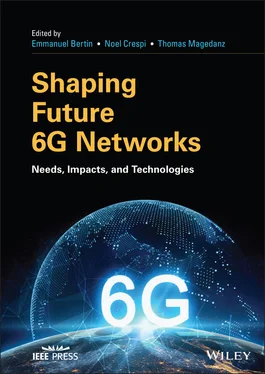Shaping Future 6G Networks
Здесь есть возможность читать онлайн «Shaping Future 6G Networks» — ознакомительный отрывок электронной книги совершенно бесплатно, а после прочтения отрывка купить полную версию. В некоторых случаях можно слушать аудио, скачать через торрент в формате fb2 и присутствует краткое содержание. Жанр: unrecognised, на английском языке. Описание произведения, (предисловие) а так же отзывы посетителей доступны на портале библиотеки ЛибКат.
- Название:Shaping Future 6G Networks
- Автор:
- Жанр:
- Год:неизвестен
- ISBN:нет данных
- Рейтинг книги:3 / 5. Голосов: 1
-
Избранное:Добавить в избранное
- Отзывы:
-
Ваша оценка:
- 60
- 1
- 2
- 3
- 4
- 5
Shaping Future 6G Networks: краткое содержание, описание и аннотация
Предлагаем к чтению аннотацию, описание, краткое содержание или предисловие (зависит от того, что написал сам автор книги «Shaping Future 6G Networks»). Если вы не нашли необходимую информацию о книге — напишите в комментариях, мы постараемся отыскать её.
Discover the societal and technology drivers contributing to build the next generation of wireless telecommunication networks Shaping Future 6G Networks: Needs, Impacts, and Technologies
Shaping Future 6G Networks
Shaping Future 6G Networks — читать онлайн ознакомительный отрывок
Ниже представлен текст книги, разбитый по страницам. Система сохранения места последней прочитанной страницы, позволяет с удобством читать онлайн бесплатно книгу «Shaping Future 6G Networks», без необходимости каждый раз заново искать на чём Вы остановились. Поставьте закладку, и сможете в любой момент перейти на страницу, на которой закончили чтение.
Интервал:
Закладка:
CDMA2000 was adopted in the United States, South Korea, Japan, China, and Canada, for example, but saw little deployment outside these countries, as most nations favored the UMTS standards defined by 3GPP. 3GPP2 subsequently pursued initiatives to create standards for the 4th generation of mobile; however, these met with little success, because, as far as IMT‐Advanced is concerned, LTE won the race and became the default commercial vehicle for 4G.
The alternatives also failed to gather significant commercial momentum (although some such as Mobile WiMAX did reach deployment in several countries) and, eventually, fell by the wayside. Different approaches to IMTs are illustrated in Figure 3.1.

Figure 3.1 IMTs and different generations of mobile network technology.
As a result, 3GPP2 effectively ceased operations in around 2013 and is now a dormant organization. This latter point may be highly significant for the future, as we shall see.
Even before this, while GSM had been promoted for 2G by ETSI, other approaches had been developed by alternative standards organizations, resulting in multiple 2G standards that enjoyed widespread adoption for a long period of time.
5G is thus something of an anomaly in the history of the mobile industry, as it represented a coordinated, single global approach to the realization of the IMT‐2020 demands. For each previous generation, there was not, at the outset, necessarily an obvious winner or a single unified approach. Will 6G see a return to such a situation, or will a global effort prevail? There are many reasons to think that 6G could well lead to fragmentation in mobile standardization. Why?
3.4 Stakeholder Ecosystem Fragmentation and Explosion
3GPP is currently the main body pushing forward with the evolution of 5G standards, but it has expanded considerably in recent years. What has driven that expansion and what might this mean for the long path towards 6G, currently being driven by early‐stage discussions in working groups of the ITU?
Since 1998, 3GPP has expanded considerably, growing from an initial five “organizational partners” and six “market representation partners.” Organizational partners are different telecommunications standard development organizations (SDOs). Currently, there are seven SDOs: Association of Radio Industries and Businesses (ARIB) and Telecommunication Technology Committee (TTC) (Japan), Telecommunications Standards Development Society India (TSDSI) (India), European Telecommunications Standards Institute (ETSI) (Europe), China Communications Standards Association (CCSA) (China), Alliance for Telecommunications Industry Solutions (ATIS) (USA), and Telecommunications Technology Association (TTA) (Korea) [6]. Market representation partners are groups representing industry and sector interests. There are 21 market representation partners, including the GSMA. Each of these has, in turn, many of its own members.
Significantly, the number of market representatives has continued to grow in recent years, with new organizations that represent the specific interests of vertical industries entering the fray. Examples include 5GACIA (the 5G Alliance for Connected Industries and Automation), 5GAA (5G Automotive Association), 5G Americas, PSCE (Public Safety Communication Europe Forum), CSAE (China Society of Automotive Engineers), and others. Each of these is thus now equivalent, in status at least, with the GSMA, which has been seen as the most significant industry group for many years. No longer – which could mean new pressures emerge that disrupt the unified approach to realizing IMTs.
Finally, there are also “observer” members, which may be new national or international SDOs that are candidates for future elevation to organizational partner status. While 3GPP has accomplished much in becoming the primary organization responsible for leading mobile standardization initiatives, it is an increasingly complicated and rapidly growing body.
Of course, on the one hand this growth speaks for the strength of the industry and the alignment that has been achieved, particularly since IMT‐Advanced was brought to fruition. On the other, it points also to an increasingly diverse spectrum of views. 3G and 4G developments were largely driven by a combination of vendor, operator, and regulator interests, with additional contributions from integrators and academia, and with the goal of realizing mobile telecommunications standards primarily for people and devices. It was a relatively simple and well‐defined community. 5G has now brought a dramatic change to this ecosystem, expanding the focus to new sectors that can benefit from wireless communications. Why, and what might it mean for 6G?
5G is the first generation of mobile technology to have been designed, from the outset, to support multiple services. This was supported by a phased implementation. First, enhanced mobile broadband (eMBB) services were launched by many operators, using 5G spectrum but also leveraging existing core assets. eMBB services are largely dedicated to personal use, for consumer and business customers, and support the standard range of mobile capabilities (data, voice, and messaging services) but with enhanced performance.
However, the second phase brought new services that can be run on 5G networks in parallel with eMBB – massive IoT (MIoT) and Ultra‐Reliable Low‐Latency Communications (URLLC). It is these new services that have driven the most profound changes to the mobile ecosystem.
That is because, while eMBB could be said to be “people‐driven,” MIoT and URLLC are largely “device‐driven” [7].
The new capabilities that 5G (Phase 2) brings are designed to service new levels of performance for connected things and processes. So, while there are undoubtedly many exciting and novel applications and services that can be enabled for people, there are expected to be many, many more for devices and applications, across multiple industries and sectors.
Indeed, it is the new use cases enabled by MIoT and URLLC that are driving the expansion of the mobile ecosystem: new stakeholders have been attracted by the potential to use wireless connectivity to service a growing range of applications.
Broadly speaking, these can be divided into two categories: public and private. According to consulting firm, Arthur D. Little, use cases extend to areas such as “mobility and public transport; public safety; healthcare; energy and utilities; education; education and retail; media and entertainment; and, industry and agriculture” [8].
Within each category, an unprecedented number of use cases (when compared with previous generations of mobile technology) can be found – and will continue to be discovered, as the market matures. As a result, a growing number of new stakeholder groups have emerged to manage contributions to mobile standard evolution from interested parties.
These have aligned over both public and private sector interests. A UK‐based software industry trade organization with more than 850 members, techUK, has noted that “the ecosystem is likely to expand rapidly” [9]. Similarly, diverse groups exist in numerous other countries. There is also a growing number of industry‐specific groups that seek to represent the interests of members from particular sectors.
As such, it seems equally likely that competing interests will emerge. Indeed, 6G is already targeted at an even broader set of use cases, based on the introduction of new features and performance capabilities. As noted, the ITU is working on a definition of these new requirements, in the shape of IMT‐2030. While this does not yet amount to 6G – and, indeed, may not [10] – this will shape new enhancements to networks and should be key considerations toward the definition of 6G. Specifically:
Читать дальшеИнтервал:
Закладка:
Похожие книги на «Shaping Future 6G Networks»
Представляем Вашему вниманию похожие книги на «Shaping Future 6G Networks» списком для выбора. Мы отобрали схожую по названию и смыслу литературу в надежде предоставить читателям больше вариантов отыскать новые, интересные, ещё непрочитанные произведения.
Обсуждение, отзывы о книге «Shaping Future 6G Networks» и просто собственные мнения читателей. Оставьте ваши комментарии, напишите, что Вы думаете о произведении, его смысле или главных героях. Укажите что конкретно понравилось, а что нет, и почему Вы так считаете.












